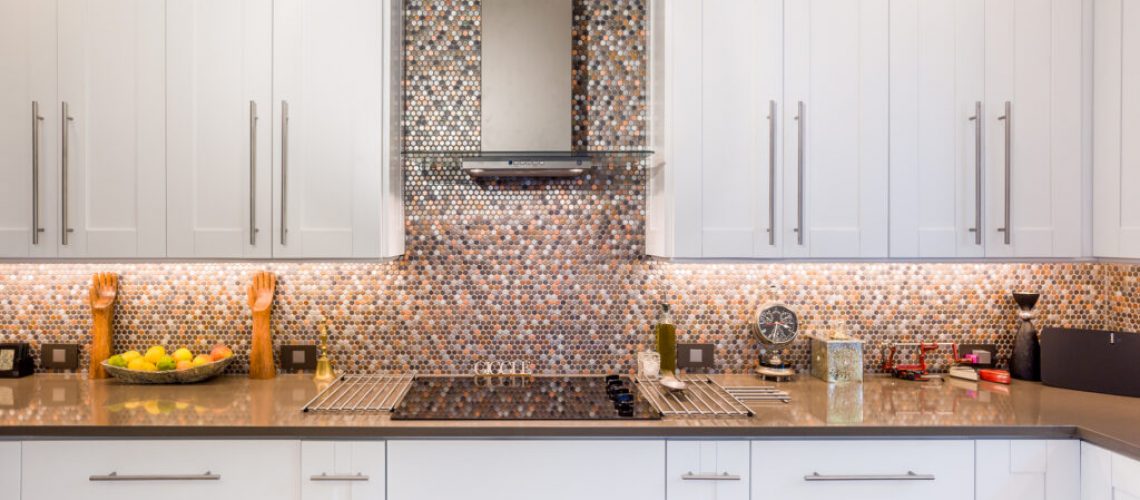This modern kitchen in Clearwater used the backsplash as its focal point. The client, an artist, hand painted some of the penny tile to get the color to her liking.
When it comes to designing a kitchen, the backsplash can be the icing on the cake that pulls everything together. A well-designed backsplash can elevate the look of the entire kitchen, adding color, texture, and personality. However, with so many options available, designing a backsplash can be a daunting task. To help you navigate the process, we’ve compiled a list of five tips for designing a kitchen backsplash that is both functional and beautiful. Whether you’re looking for something timeless or trendy, these tips will help you create a backsplash that suits your style and enhances your kitchen’s overall aesthetic.
Before we dive into the tips, let’s define what a backsplash is. A backsplash is a vertical extension of a counter, usually found in a kitchen or bathroom. Its primary function is practicality — it guards against accidental splashing that could cause water damage to the wall behind the sink. It does, however, provide ample design opportunities. Many people think of backsplash like jewelry — it can be soft and subtle, or it can add a touch of character to your kitchen that you might not otherwise have.
Now, let’s get into the tips:
1. Consider your kitchen’s style. The design of your kitchen can influence the design of your backsplash. For example, if you have a minimalist kitchen, you may want to consider white ceramic subway tile in a straight stack pattern. If you have a modern kitchen, mosaic tiles may be a better option. If you prefer a rustic look, natural stone tiles could be a good choice. Ceramic tiles are the most popular choice for backsplashes due to their durability and affordability. Glass tiles are a stylish option that can create a sleek and modern look, while stone tiles offer a natural and rustic feel but require more maintenance.
This traditional-style kitchen in Harbor Oaks, Clearwater, features a classic, white subway tile made of ceramic.
2. Think about color and pattern. A continuous color flow that is created when you match the backsplash tile to the color of your countertops gives your kitchen a finishing touch. For instance, cream, beige, brown, or gray backsplash tiles frequently go with granite, wood, or artificial countertops that are neutral in color. Pattern options for backsplashes include subway tiles, mosaic tiles, hexagonal tiles, herringbone, chevron, straight, and diamond-shaped tiles. Choosing a backsplash pattern can be a daunting task, as it can significantly impact the overall look and feel of your kitchen. The backsplash pattern should complement the existing color scheme of your kitchen. Look for patterns that include colors that already exist in your kitchen, or choose a neutral pattern that won’t clash with your existing color scheme.
3. Keep it simple in small kitchens. A light-colored backsplash can make a small kitchen feel more spacious. Consider using neutral colors like white, cream, or beige. Intricate patterns can make a small space feel cluttered. Stick to simple patterns like subway tiles or small, light-colored mosaic tiles. Reflective materials like glass or metal can make a small kitchen feel brighter and more open. The key to designing a backsplash for a small kitchen is to keep it simple and functional while adding a touch of style and personality.
Our client in St. Pete, Florida, chose to continue her marble countertops up into her backsplash. This is a traditional look that is very luxe, especially if you love natural materials like stone.
4. Choose the right material. The material of your backsplash can impact the overall look and feel of your kitchen. If you have a lot of natural materials in your kitchen, you may want to choose a backsplash made of stone or tile. If you have a more modern kitchen, a glass or metal backsplash can be a great option.
5. Don’t forget the grout. The color of the grout can make a big difference in the overall look of your backsplash. If you have small tiles, using grout that is a similar color to the tile can help create a cohesive look. If you have larger tiles, a contrasting grout color can help highlight the individual tiles and create a more dramatic effect. Consider using a grout color that matches the tile for a clean and streamlined look in a modern or minimalist space, or a contrasting grout color for a unique and interesting look.
Nelson Construction and Renovations, a family business founded in 2006, is a design-build company that specializes in high-end remodels, home additions, and custom homes. With our headquarters in Clearwater, Florida, we serve homeowners all over Pinellas and Hillsborough Counties. We are an award-winning member of the National Association of the Remodeling Industry and have an A+ rating with the Better Business Bureau.
Creative Commons Attribution: Permission is granted to re-post this article in its entirety with credit to Nelson Construction and a clickable link back to this page
